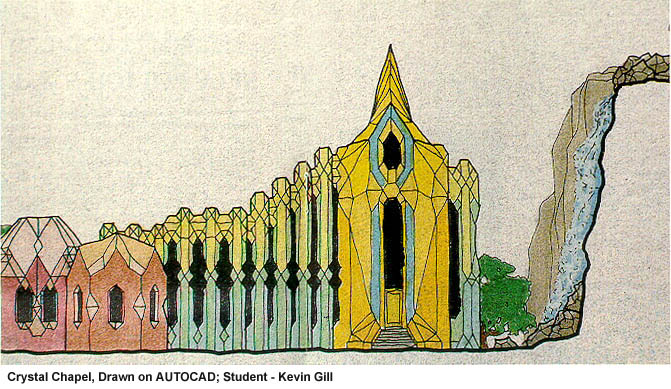Available via Distance Learning.
Units: 36
Courses: 12
Tuition: $4,200
Enroll by printable enrollment form

Architecture Program One
Prerequisites: Anyone may enroll in Architecture Program One
Distance Learning students may take as few or as many courses as desired, but to earn the Associate of Arts Degree and Technical Certificate, a total of 12 courses (for 36 units) is required. This program offers an overview introduction to the basics of architectural design, professional practice, and construction.
Successful completion of Program One will qualify a student for intern-level drafting or design graphics work in building design or architecture offices. Besides offering professional-level education, these courses provide excellent preparation for those who want to design and build their own personal environments or become developers of small-scale building projects.
Creative Resources
A 101
Creative Problem Solving
3 units
A series of excellent exercises for enhancing personal and professional creativity.
Textbook: Conceptual Blockbusting: A Guide to Better Ideas, by James L. Adams
A 102
History of Architecture: Western and Eastern
3 units
The origins of our architectural heritage and the relationships between the great architectural cultures of the world. Textbook: A World History of Architecture, by Marian Moffett, et al
Media
A 103
Introduction to Two-Dimensional Composition
3 units
Basic exercises for developing skills and an “eye” for composition. Textbook: Architecture: Form, Space, and Order, by Frank D. K. Ching and Francis D. Ching
A 104
Freehand Drawing and Sketching
3 units
Anyone can learn to draw, and the author of these textbooks has proven this for many years. Textbooks: The New Drawing on the Right Side of the Brain, by Betty Edwards and New Drawing on the Right Side of the Brain Workbook, by Betty Edwards
A 105
Introduction to Architectural Drafting
3 units
Drafting, whether by hand or by Computer-Aided Drafting (CAD), requires a basic knowledge of architectural conventions and standards. Textbooks: Architectural Graphics (chapters 1-3), by Francis D. K. Ching and A Manual of Construction Documentation: An Illustrated Guide to Preparing Construction Drawings, by Glen Wiggens
Building Design and Site Planning
A 106
Introduction to Site Analysis
3 units
Buildings start with the site, and one of the most common causes of multiple problems in buildings is inadequate or flawed site analysis. Textbook: Design with Nature, by Ian L. McHarg
A 107
Basic Principles of Building Design and Planning, Part One
3 units
Anyone can learn to plan buildings well; here are the basics. Textbook: The Natural House, by Frank Lloyd Wright Note: This book is out of print but available through used book dealers or Amazon.com
A 108
Basic Principles of Building Design and Planning, Part Two
3 units
Textbook: Form, Function, and Design, by Paul Jacques Grillo
Construction and Engineering
A 109
Introduction to Building Materials & Construction
3 units
Building materials must be carefully chosen according to their fundamental characteristics, values, and vulnerabilities. This course reviews the essential data architects need to understand the basic materials and how they’re assembled. Textbook: Building Construction Illustrated, 3rd edition, by Francis D. K. Ching and Cassandra Adams
A 110
Introduction to Structural Engineering: How Buildings Stand Up
3 units
The calculations for structural engineering can be tedious, but the fundamental principles are easily grasped when clearly explained, as they are in this course. No math is used in this course. Textbook: Why Buildings Stand Up: The Strength of Architecture, by Mario G. Salvadori
A 111
Introduction to Environmental Engineering & Ecological Design
3 units
Many building interior environments are so polluted, they are significant health hazards; others actually support good health. This course delineates the differences. Textbook: Big and Green: Toward Sustainable Architecture in the 21st Century, by David Gissen, Editor.
Management and Finance
A 112
Introduction to Architectural Management & Professional Practice
3 units
Architects spend most of their time on management, but they’re usually poorly prepared for what’s required. This introduction deals with the basic components of architectural practice and is an excellent lead-in to more advanced studies. Textbook: The Architect’s Handbook of Professional Practice, student edition, by Joseph A. Demkin
